“What does a Dead Man’s Hand tattoo truly represent?” This is a question that echoes through the minds of those captivated by the world of tattoos. Inked with mystery and allure, the Dead Man’s Hand tattoo holds a captivating significance that has piqued the curiosity of body art enthusiasts around the globe. In this comprehensive article, we will delve deep into the origins, symbolism, and cultural connotations behind this macabre design. So, fasten your seat belts as we embark on an intriguing journey exploring the meaning of the Dead Man’s Hand tattoo.
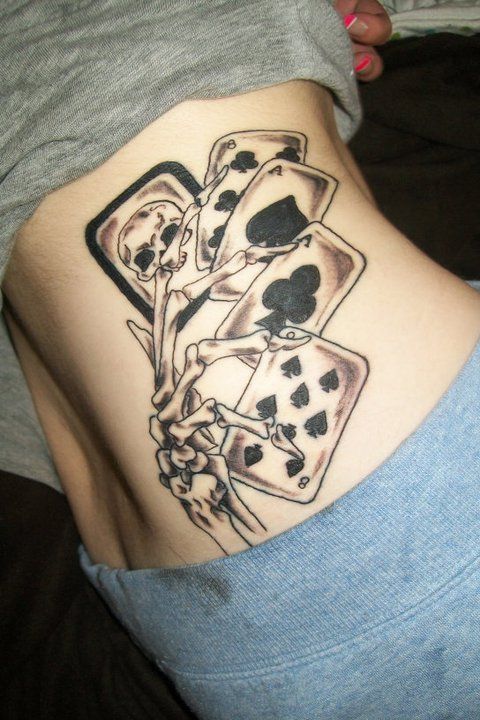
The Origins of Dead Man’s Hand Tattoo: Tales from the Wild West
Why is the Dead Man’s Hand tattoo associated with the Wild West?
The Wild West, an era steeped in legends and folklore, serves as the birthplace of the Dead Man’s Hand tattoo. This emblematic design pays homage to a fateful game of poker played on August 2, 1876, in the town of Deadwood, Dakota Territory. The hand held by gunslinger Wild Bill Hickok at the time of his untimely demise became forever etched in history and popular culture, inspiring countless individuals to immortalize it on their skin.
Deciphering the Symbolism: What Does the Dead Man’s Hand Mean?
A Mark of Ill Fate
The Dead Man’s Hand tattoo is a powerful and evocative symbol that serves as a constant reminder of the unpredictable nature of life. It encapsulates the essence of ill fortune and impending doom, acting as a visual representation of the fragility of existence and the inevitability of mortality. This tattoo design typically depicts a specific hand of cards: two black aces and two black eights, with the fifth card varying in different interpretations.
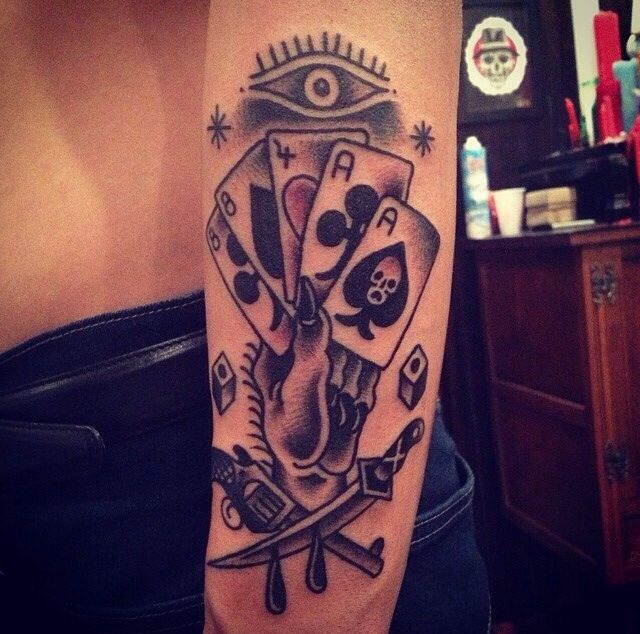
The history behind this tattoo dates back to a legendary poker game that took place in 1876 in Deadwood, South Dakota. During this fateful game, a renowned Old West gunslinger named Wild Bill Hickok was dealt the infamous hand just moments before he was shot dead by Jack McCall, an aspiring gambler seeking revenge. Ever since that tragic incident, the Dead Man’s Hand has become synonymous with bad luck and serves as a chilling reminder of the transitory nature of life.
By choosing to adorn oneself with a Dead Man’s Hand tattoo, individuals embrace the notion that life is inherently uncertain and that misfortune can strike at any moment. It acts as a sobering memento mori, urging one to recognize their mortality and encouraging the appreciation of each passing moment. This tattoo carries a sense of urgency, reminding people to seize the day and not take anything for granted.
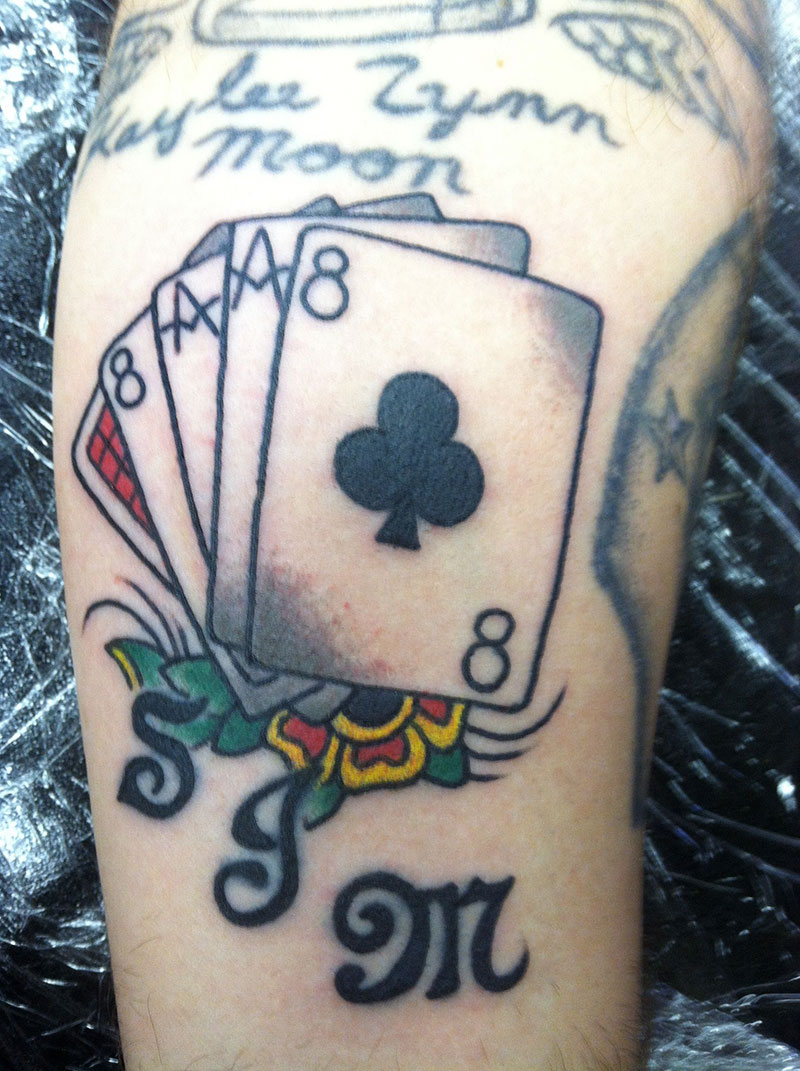
The symbolism inherent in the Dead Man’s Hand tattoo is multifaceted. Firstly, it conveys the concept of ill fortune, signifying that no matter how skillfully one plays their cards, they may still fall victim to unfavorable circumstances beyond their control. It serves as a stark reminder that life’s outcomes are often not entirely within our grasp, highlighting the need to approach every situation with humility and adaptability.
Secondly, the tattoo captures the essence of impending doom and mortality. The image of the four cards represents the hand that Wild Bill Hickok held when he met his untimely demise. It serves as a chilling reminder that death is an inevitable and inescapable part of the human experience. The Dead Man’s Hand tattoo encourages introspection and reflection on one’s own mortality, prompting individuals to contemplate the finite nature of their existence and make the most of the time they have.
A Tribute to Wild Bill Hickok
The Dead Man’s Hand tattoo design is a powerful and intricately designed symbol that serves as a tribute to the iconic gunslinger, Wild Bill Hickok. This tattoo captures the essence of Hickok’s legendary status, immortalizing his memory and legacy for generations to come.
Wild Bill Hickok was a fearless and skilled marksman who gained fame during the tumultuous era of the Wild West. He was known for his exceptional gunfighting skills, unwavering courage, and his ability to maintain calmness in the face of danger. Hickok’s reputation as a formidable gunslinger and lawman has made him an enduring figure in American folklore.
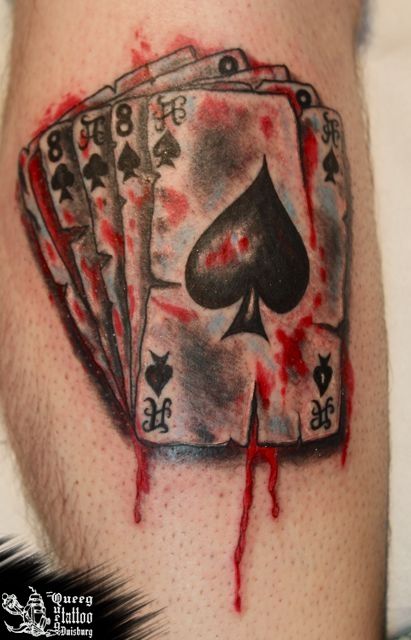
The Dead Man’s Hand tattoo is inspired by a historical event that took place on August 2, 1876, in the town of Deadwood, Dakota Territory. During a fateful poker game, Hickok was dealt a hand consisting of two black aces and two black eights, along with an unknown fifth card. This hand became known as the “Dead Man’s Hand” due to its association with Hickok’s untimely demise.
By wearing the Dead Man’s Hand tattoo, individuals express their deep admiration for Wild Bill Hickok’s bravery and his willingness to confront the dangers of the Wild West head-on. This tattoo encapsulates the spirit of adventure, fearlessness, and resilience that characterized the era.
The design of the Dead Man’s Hand tattoo often features the four cards – two black aces and two black eights – arranged in a distinctive pattern. It may include additional elements such as playing card motifs, revolvers, cowboy hats, or other symbols associated with the Wild West. The tattoo can be rendered in various styles, ranging from realistic to illustrative or even incorporating elements of traditional American tattoo art.
This tattoo serves as a visual reminder of the courage and audacity exhibited by Wild Bill Hickok throughout his life. It signifies the wearer’s affinity for the spirit of the Wild West and their admiration for those who fearlessly walked its treacherous paths. It is a symbol of respect for a man who became a legend in his own time, leaving an indelible mark on American history.
A Warning Against Gambling
The Dead Man’s Hand tattoo is a symbolic image that can hold multiple meanings, including serving as a cautionary symbol against the perils of gambling. This tattoo design typically depicts a specific poker hand consisting of two black aces and two black eights, with an unknown fifth card. The origin of this ominous name and its association with a losing hand dates back to a historical event from the Old West in the late 1800s.
Legend has it that the Dead Man’s Hand originated from an actual game of poker played by the famous lawman Wild Bill Hickok in the town of Deadwood, South Dakota, in 1876. During the game, Hickok was dealt two black aces and two black eights, along with an unknown fifth card. It was at this moment that he was fatally shot in the back, making this particular hand forever infamous as the Dead Man’s Hand.
Due to its tragic association with Hickok’s death, the Dead Man’s Hand tattoo serves as a stark reminder of the dangers and pitfalls of gambling. In the context of the Old West, saloons and poker tables were notorious for attracting individuals who were often consumed by vices such as gambling, alcohol, and violence. The Dead Man’s Hand tattoo, with its representation of a losing hand, carries a cautionary message encouraging individuals to exercise prudence and avoid succumbing to these destructive habits.
By wearing the Dead Man’s Hand tattoo, individuals may choose to showcase their personal commitment to responsible gambling or to serve as a constant reminder to themselves and others about the potential consequences of excessive gambling. It acts as a visual symbol urging caution and moderation when engaging in games of chance.
Moreover, the tattoo can also function as a sign of respect for the history and folklore of the Old West. By embracing this emblematic imagery, wearers pay homage to the era’s rich storytelling and the legends that have been passed down through time.
Embracing Individuality
In a world where conformity often reigns, societal norms dictate and shape the behavior, appearance, and perspectives of individuals, creating a homogeneous environment. However, amidst this sea of uniformity, there exists a group of people who bear the Dead Man’s Hand tattoo—a symbol that represents their embrace of uniqueness and defiance of societal expectations.
The Dead Man’s Hand tattoo is not just an ordinary emblem inked on one’s body; it carries a deeper meaning and significance. It is a macabre symbol that distinguishes its bearers from the crowd, serving as a visual testament to their individuality and willingness to stand apart from the masses. It represents a rebellion against the pressures and constraints imposed by society, encouraging the celebration of personal identity and self-expression.
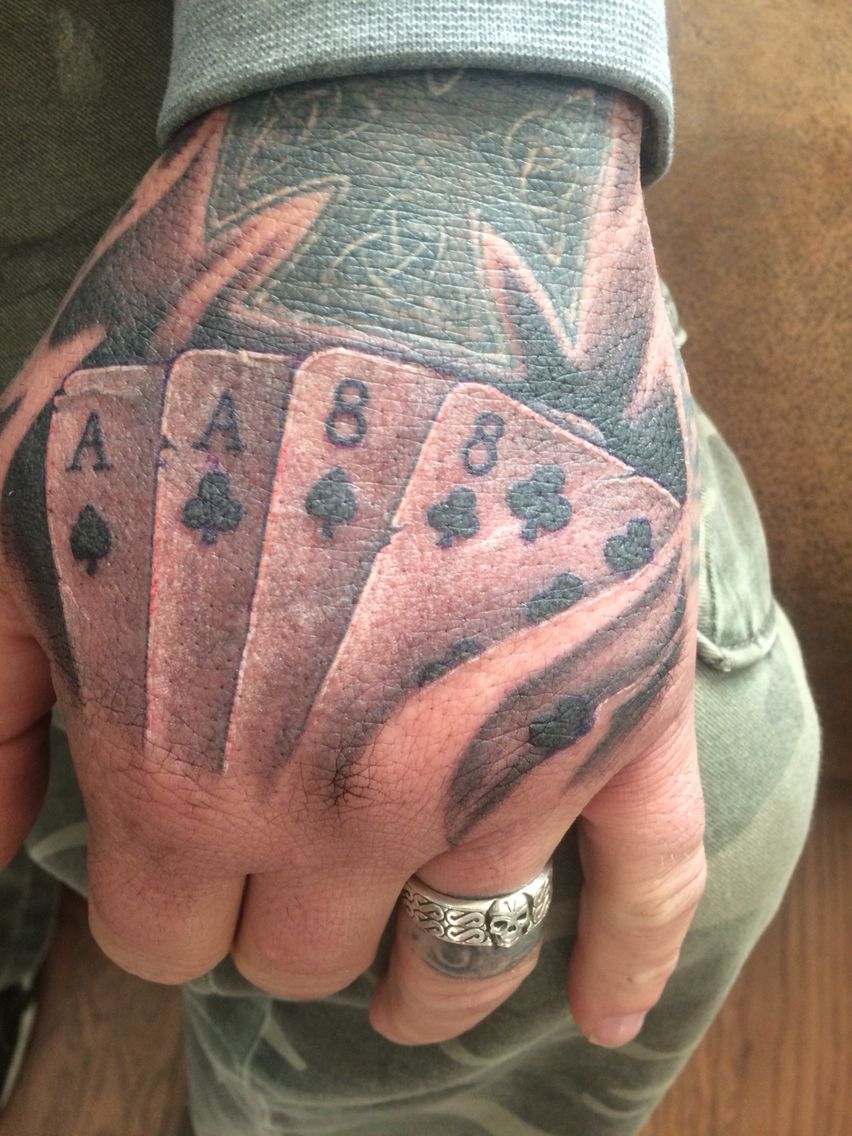
The image of the Dead Man’s Hand—a poker hand consisting of two black aces, two black eights, and an unknown fifth card—conjures a sense of mystery and intrigue. Its origin stems from a historical event, specifically the infamous Wild West shooting of gunslinger Wild Bill Hickok in 1876. The cards found in his hand after his death forever became known as the Dead Man’s Hand, forever etching their place in folklore.
By choosing to bear this tattoo, individuals willingly embrace the legacy and symbolism associated with the Dead Man’s Hand. It becomes a badge of honor, signifying a departure from the mundane and a rejection of societal pressures to conform. These individuals are unafraid to be different, realizing that their uniqueness is what sets them apart and brings them closer to their true selves.
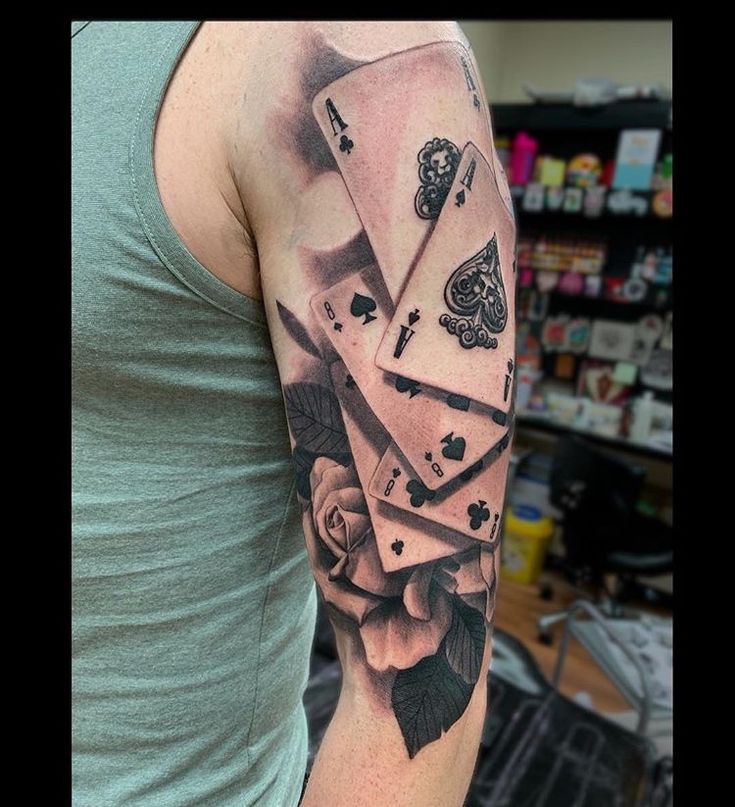
The Dead Man’s Hand tattoo also serves as a powerful reminder to its bearers of their mortality and the transient nature of life. It reminds them that in the face of mortality, they strive to make their existence count, living authentically and embracing their passions and aspirations without fear of judgment or rejection. It becomes a permanent mark on their bodies, a visual representation of their commitment to living life on their own terms.
In a society where conformity can stifle creativity and suppress individuality, those who bear the Dead Man’s Hand tattoo stand as beacons of inspiration. They encourage others to embrace their own uniqueness, to challenge societal norms, and to live life according to their own values and desires. The tattoo becomes not only a symbol of rebellion but also a catalyst for change, promoting a world that celebrates diversity and encourages the pursuit of individual passions.
Why do people choose to get a Dead Man’s Hand tattoo?
- An Iconic Piece of History: The allure of the Wild West and its enigmatic characters continues to captivate our collective imagination. Donning a Dead Man’s Hand tattoo allows individuals to immerse themselves in the rich tapestry of history and connect with an era defined by lawlessness, adventure, and untamed spirits.
- A Symbol of Rebellion: Tattoos have long served as an expression of rebellion against societal norms. The Dead Man’s Hand tattoo, with its edgy and ominous aesthetic, serves as a rebellious statement, challenging conventional ideas of beauty and acceptance.
- Personal Reflection and Remembrance: For some individuals, the Dead Man’s Hand tattoo acts as a personal reflection on their own mortality. It serves as a poignant reminder to cherish every moment and make the most of life’s fleeting opportunities. Additionally, it can be a tribute to loved ones who have passed away, serving as a permanent memorial etched onto their skin.
- Artistic Expression: Tattoos are also a form of artistic expression, allowing individuals to wear their creativity on their sleeves—literally. The Dead Man’s Hand tattoo, with its intricate details and symbolic significance, provides artists and tattoo enthusiasts alike with a powerful canvas to showcase their skills and tell captivating stories through ink.
In Conclusion
The Dead Man’s Hand tattoo is more than just an inked design; it is a powerful symbol that encapsulates the spirit of the Wild West, mortality, rebellion, and individuality. Its origins rooted in history and its macabre aesthetics have made it an intriguing choice for tattoo enthusiasts worldwide. Whether you resonate with the cautionary tale of gambling, pay tribute to Wild Bill Hickok, or simply appreciate the unique visual appeal, the Dead Man’s Hand tattoo speaks volumes about the wearer’s experiences, beliefs, and desires. So, if you are contemplating adorning your skin with this mystical emblem, remember to choose a skilled artist who can bring your vision to life while honoring the rich symbolism behind the Dead Man’s Hand tattoo.
And there you have it—the captivating story and meaning of the Dead Man’s Hand tattoo. May this article have shed light on the allure and significance of this macabre design, inspiring you to explore the depths of your own storytelling through body art. Embrace the power of expression and let your inked canvas tell its extraordinary tale.

I am Harvey Berry, a tattoo enthusiast who has immersed himself in the diverse world of ink, passionately exploring the beauty and artistry within each tattoo. My mission extends beyond uncovering the aesthetics of tattooing; it involves sharing in-depth knowledge across all aspects of this art form.
Fueled by genuine curiosity and love for every facet of tattooing, I have diligently crafted well-researched articles, with a special focus on the Tattoo Meaning of Impeccable Nest section. Here, my aim is to help the tattoo community gain a deeper understanding of the meanings and values embedded in each tattoo.
One of my primary goals is to encourage responsible decision-making when it comes to getting inked. I recognize that choosing to get a tattoo is a significant personal decision that requires careful consideration. Hence, I provide diverse resources covering the meaning of tattoos, the tattooing process, aftercare tips, and other valuable information.
Whether you are a seasoned tattoo enthusiast or embarking on your first exploration of the world of body art, I aspire to be a reliable resource for you at every step of your journey. I hope that my extensive knowledge of tattoos, especially in the Tattoo Meaning section, will assist you in finding inspiration to express yourself through the art of tattoos.
